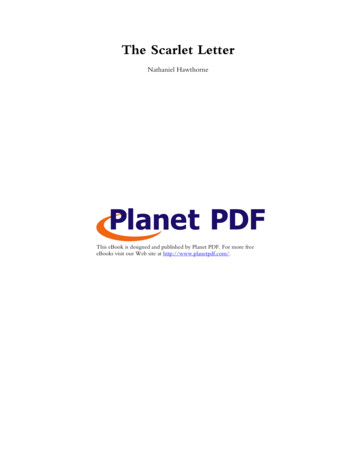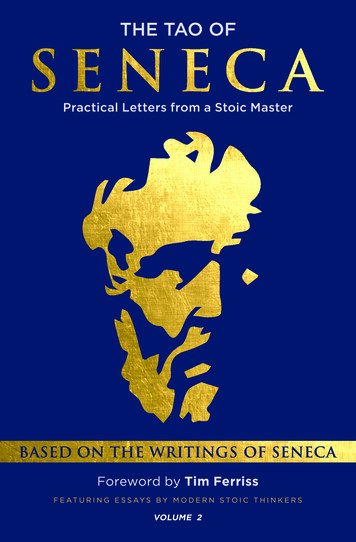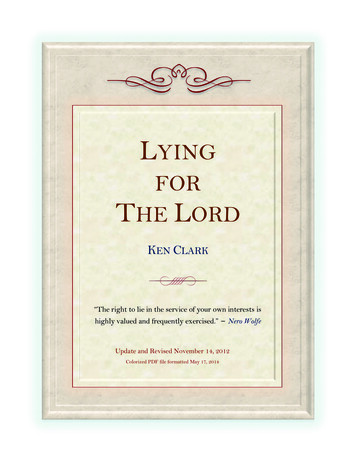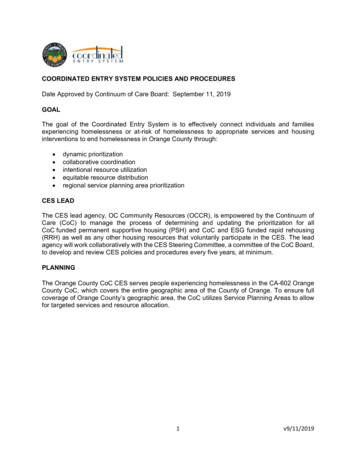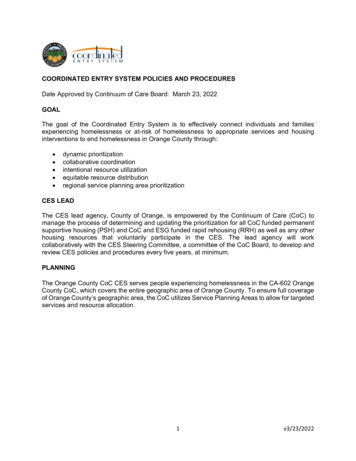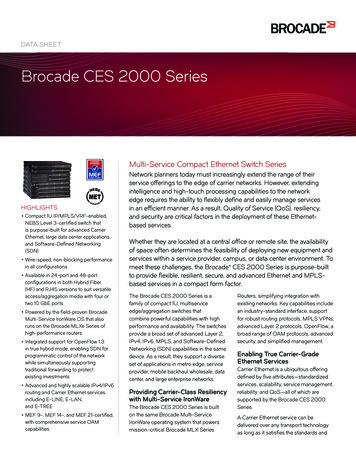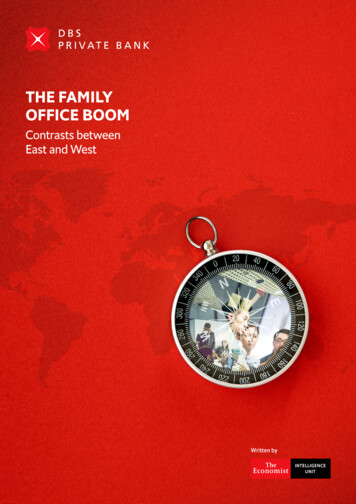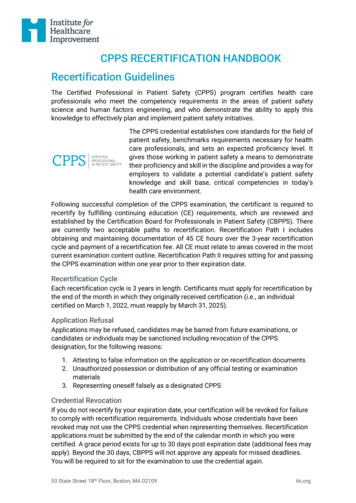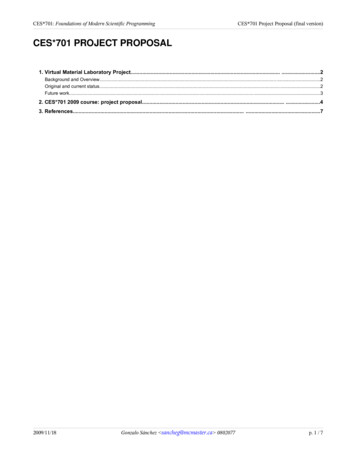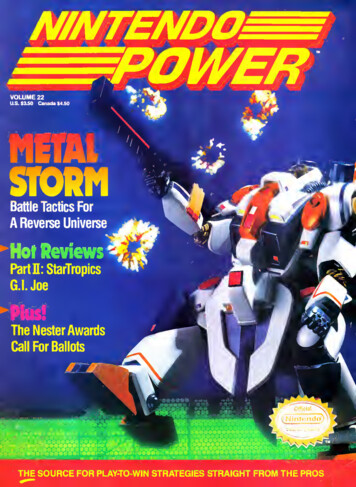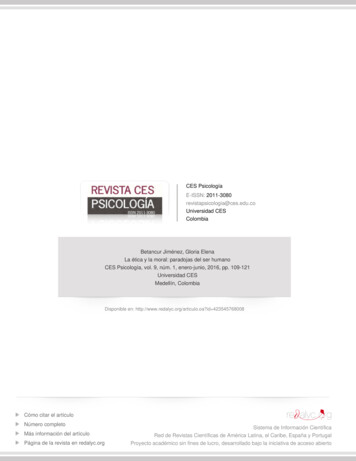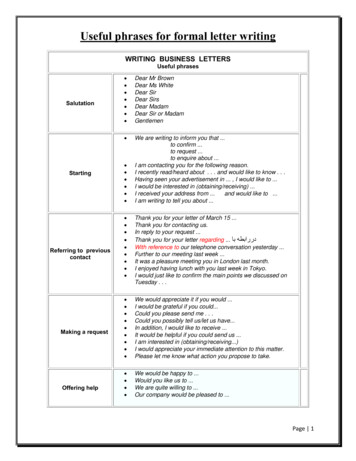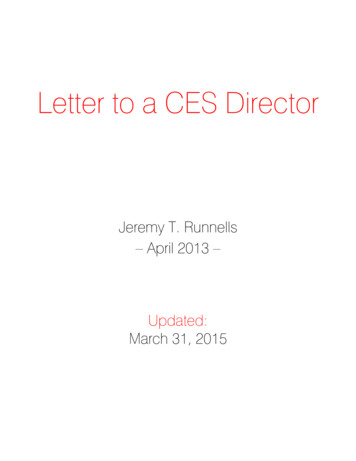
Transcription
Letter to a CES DirectorJeremy T. Runnells– April 2013 –Updated:March 31, 2015
To my beautiful young children that you may one day understand.To access the digital PDF copy containing the URL links:www.cesletter.comThis work is licensed under a Creative Commons Attribution-NonCommercial 3.0 Unported License.You may share, distribute, alter, and build upon this work so long as you respect the following: Do not put my name in your new paper or imply that I support or endorseyour new paper in any way.Do not use “CES Letter” or “Letter to a CES Director” or imply that it’s asequel (example: CES Letter – Part 2) in your new paper.Do not sell, print or offer existing CES Letter or your new work for profit orcommercial purposes.Do not set up or offer CES Letter for mass print on lulu.com or any other printers.Respect the art work by keeping intact its URL links acknowledging itsowners.
“If we have the truth, it cannot be harmed by investigation.If we have not the truth, it ought to be harmed.”– President J. Reuben Clark –
ContentsIntroduction .5Book of Mormon . 6Book of Mormon Translation . 20First Vision . 22Book of Abraham . 24Polygamy/Polyandry . 31Prophets . 37Kinderhook Plates . 43Testimony/Spiritual Witness . 45Priesthood Restoration . 49Witnesses . .50Temples & Freemasonry . 66Science . 67Scriptures . 69Other Concerns . 71Conclusion. 79
Introduction[Name of CES Director Removed],Thank you for responding to my grandfather's request to answer my concerns and questions and foroffering your time with me. I appreciate it.I’m interested in your thoughts and answers as I have been unable to find official answers from theChurch for most of these issues. I’m hoping you’re going to have better answers than many of theones given by unofficial apologists such as FAIR and Neal A. Maxwell Institute (formerly FARMS).I’m just going to be straightforward and blunt in sharing my concerns. Obviously I’m a disaffectedmember who lost his testimony so it’s no secret which side I’m on at the moment. All this informationis a result of over a year of intense research and an absolute rabid obsession with Joseph Smith andChurch history. With this said, I’d be pretty arrogant and ignorant to say that I have all theinformation and that you don’t have answers. Like you, I put my pants on one leg at a time and Isee through a glass darkly. You may have new information and/or a new perspective that I maynot have heard or considered before. This is why I’m genuinely interested in what your answersand thoughts are to these troubling problems.I’ve decided to lay down just about all the major concerns that I have. I went through my notesfrom my past year of research and compiled them together. It doesn’t make sense for me to just laydown 5 concerns while I also have 20 other legitimate concerns that are keeping me from believingthe truth claims of the LDS Church.A quick background might be helpful as to where I'm coming from. I was a very active and fullybelieving member my entire life up until around the summer of 2012. My grandpa already outlinedmy life events to you in his email so I think you get the idea that I accepted and embraced Mormonism.In February of 2012, I was reading the news online when I came across the following news article:Mormonism Besieged by the Modern Age. In the article was information about a Q&A meeting atUtah State University that LDS Church Historian and General Authority, Elder Marlin K. Jensen gave inlate 2011. He was asked his thoughts regarding the effects of Google on membership and peoplewho are "leaving in droves" over Church history.Elder Marlin K. Jensen's response:"Maybe since Kirtland, we've never had a period of – I'll call it apostasy, likewe're having now; largely over these issues "This truly shocked me. I didn't understand what was going on or why people would leave "overhistory." I started doing research and reading books like LDS historian and scholar RichardBushman’s Rough Stone Rolling and many others to try to better understand what was happening.The following issues are among my main concerns:5
Book of Mormon Concerns & Questions:1.What are 1769 King James Version edition errors doing in the Book of Mormon? Anancient text? Errors which are unique to the 1769 edition that Joseph Smith owned?2.When King James translators were translating the KJV Bible between 1604 and 1611, theywould occasionally put in their own words into the text to make the English morereadable. We know exactly what these words are because they're italicized in the KJVBible. What are these 17th century italicized words doing in the Book of Mormon? Wordfor word? What does this say about the Book of Mormon being an ancient record?Examples:The above example, 2 Nephi 19:1, dated in the Book of Mormon to be around 550 BC,quotes nearly verbatim from the 1611 AD translation of Isaiah 9:1 KJV – including thetranslators’ italicized words. Additionally, Joseph qualified the sea as the Red Sea. Theproblem with this is that (a) Christ quoted Isaiah in Matt. 4:14-15 and did not mention theRed Sea, (b) “Red” sea is not found in any source manuscripts, and (c) the Red Sea is 250miles away.6
In the above example, the KJV translators added 7 italicized words not found in the sourceHebrew manuscripts to its English translation. Why does the Book of Mormon, completed1,200 years prior, contain the exact identical seven italicized words of 17th centurytranslators?3.The Book of Mormon includes mistranslated biblical passages that were later changed inJoseph Smith’s translation of the Bible. These Book of Mormon verses should match theinspired JST version instead of the incorrect KJV version that Joseph later fixed. A typicalexample of the differences between the BOM, the KJV, and the JST:3 Nephi 13:25-27:25: Therefore I say unto you, take no thought for your life, what ye shall eat, or what yeshall drink; nor yet for your body, what ye shall put on. Is not the life more than meat,and the body than raiment?26: Behold the fowls of the air, for they sow not, neither do they reap nor gather into barns;yet your heavenly Father feedeth them. Are ye not much better than they?27: Which of you by taking thought can add one cubit unto his stature?Matthew 6:25-27 (from the King James Version Bible – not the JST):25: Therefore I say unto you, Take no thought for your life, what ye shall eat, or what yeshall drink; nor yet for your body, what ye shall put on. Is not the life more than meat,and the body than raiment?26: Behold the fowls of the air: for they sow not, neither do they reap, nor gather intobarns; yet your heavenly Father feedeth them. Are ye not much better than they?27: Which of you by taking thought can add one cubit unto his stature?The above Sermon on the Mount passages are identical, which is understandable as Christmay have said the same thing to both groups of people in the Old world as well as theNew world. Let’s look at the JST version of the above identical passages:Joseph Smith Translation of the same passages in the LDS Bible for Matthew 6:25-27:25: And, again, I say unto you, Go ye into the world, and care not for the world: for theworld will hate you, and will persecute you, and will turn you out of their synagogues.26: Nevertheless, ye shall go forth from house to house, teaching the people; and I will gobefore you.27: And your heavenly Father will provide for you, whatsoever things ye need for food,what ye shall eat; and for raiment, what ye shall wear or put on.Christ’s Sermon on the Mount in the Bible and the Book of Mormon are identical. JosephSmith corrected the Bible. In doing so, he also corrected the same identical Sermon on theMount passage in the Book of Mormon. The Book of Mormon is “the most correct book”and was translated a mere decade before the JST. The Book of Mormon was not corruptedover time and did not need correcting. How is it that the Book of Mormon has the incorrectSermon on the Mount passage and does not match the correct JST version in the first place?7
4.DNA analysis has concluded that Native American Indians do not originate from the MiddleEast or from Israelites but rather from Asia. Why did the Church change the followingsection of the introduction page in the 2006 edition Book of Mormon shortly after the DNAresults were released?“ the Lamanites, and they are the principal ancestors of the American Indians”to“ the Lamanites, and they are among the ancestors of the American Indians”5.Anachronisms: Horses, cattle, oxen, sheep, swine, goats, elephants, wheels, chariots,wheat, silk, steel, and iron did not exist in pre-Columbian America during Book of Mormontimes. Why are these things mentioned in the Book of Mormon as being made available inthe Americas between 2200 BC - 421 AD?6.Archaeology: There is absolutely no archaeological evidence to directly support the Book ofMormon or the Nephites/Lamanites who numbered in the millions. This is one of thereasons why unofficial apologists are coming up with the Limited Geography Model (ithappened in Central or South America) and that the real Hill Cumorah is not in Palmyra,New York but is elsewhere and possibly somewhere down there instead. This is in directcontradiction to what Joseph Smith and other prophets have taught. Never mind that theChurch has a visitor’s center there in New York and holds annual Hill Cumorah pageants.We read about two major war battles that took place at the Hill Cumorah (Ramah to theJaredites) that numbered in the deaths of at least 2,000,000 people. No bones, hair,chariots, swords, armor, or any other evidence found whatsoever.Compare this to the Roman occupation of Britain and other countries. There are abundantevidences of their presence during the first 400 years AD such as villas, mosaic floors,public baths, armor, weapons, writings, art, pottery and so on. Even the major road systemsused today in some of these occupied countries were built by the Romans. Additionally,there is ample evidence of the Mayan and Aztec civilizations as well as a civilization incurrent day Texas that dates back 15,000 years. Where are the Nephite or Lamanitebuildings, roads, armors, swords, pottery, art, etc.?Latter-day Saint Thomas Stuart Ferguson was BYU’s archaeology division (New WorldArchaeological Funding) founder. NWAF was financed by the Church. NWAF andFerguson were tasked by BYU and the Church in the 1950s and 1960s to findarchaeological evidence to support the Book of Mormon. This is what Ferguson wrote after17 years of trying to dig up evidence for the Book of Mormon:“ you can’t set Book of Mormon geography down anywhere – because it isfictional and will never meet the requirements of the dirt-archaeology. I shouldsay – what is in the ground will never conform to what is in the book.”– Letter dated February 2, 19768
7.Book of Mormon Geography: Many Book of Mormon names and places are strikinglysimilar to many local names and places of the region Joseph Smith lived.The following two maps show Book of Mormon geography compared to Joseph Smith'sgeography:Book of Mormon GeographyJoseph Smith’s Geography(Northeast United States & Southeast Canada)The first map is the "proposed map," constructed from internal comparisons in the Book ofMormon.9
Throughout the Book of Mormon we read of such features as "The Narrow Neck of Land"which was a day and a half's journey (roughly 30 miles) separating two great seas. Weread much of the Hill Onidah and the Hill Ramah – all place names in the land of JosephSmith's youth.We read in the Book of Mormon of the Land of Desolation named for a warrior namedTeancum who helped General Moroni fight in the Land of Desolation. In Smith's era, anIndian Chief named Tecumseh fought and died near the narrow neck of land helping theBritish in the War of 1812. Today, the city Tecumseh (near the narrow neck of land) isnamed after him.We see the Book of Mormon city Kishkumen located near an area named, on modernmaps, as Kiskiminetas. There are more than a dozen Book of Mormon names that are thesame as or nearly the same as modern geographical locations.Actual Place mJordanKishkiminetasLehighMantuaMoraviantownNoah LakesOneidaOneida CastleRamaRipple LakeSodomShilohSherbrookeBook of Mormon Place NamesAlma, Valley ishkumenLehiMantiMoriantonNoah, Land ofOnidahOnidah, HillRamahRipliancum, Waters ofSidomShilomShurrSource: Book of Mormon Authorship: A Closer Look, Vernal HolleyWhy are there so many names similar to Book of Mormon names in the region where JosephSmith lived? This is all just a coincidence?10
Hill Cumorah:Off the eastern coast of Mozambique in Africa is an island country called “Comoros.” Priorto its French occupation in 1841, the islands were known by its Arabic name, “Camora.”There is an 1808 map of Africa that refers to the islands as “Camora.”Camora is near center in the above 1808 Map of AfricaThe largest city and capital of Comoros (formerly “Camora”)? Moroni. “Camora” andsettlement “Moroni” were common names in pirate and treasure hunting stories involvingCaptain William Kidd (a pirate and treasure hunter) which many 19th century NewEnglanders – especially treasure hunters – were familiar with.In fact, the uniform spelling for Hill Cumorah in the 1830 edition of the Book of Mormon isspelled as “Camorah.”Pomeroy Tucker was born in Palmyra, New York in 1802, three years before Joseph Smith.He is considered to be a contemporary source. This is what he said about Joseph Smith:"Joseph . had learned to read comprehensively . [reading] works of fiction andrecords of criminality, such for instance as would be classed with the 'dime novels'of the present day. The stories of Stephen Buroughs and Captain Kidd, and thelike, presented the highest charms for his expanding mental perceptions."– Mormonism: Its Origin, Rise, and Progress, p.17Some apologists say that Tucker’s Mormonism: Its Origin, Rise, and Progress is anti-Mormonand thus anything in the book cannot be trusted. The problem with this premise is that LDSscholar and Church history compiler B.H. Roberts quoted Tucker for background informationon Joseph and FairMormon has an article where they quoted Tucker 4 times from his bookas support for Joseph and even referred to Tucker as an “eye witness” to Joseph and hisfamily. Is Tucker’s peripheral information only useful and accurate when it shows Joseph andthe Church in a positive and favorable light?"We are sorry to observe, even in this enlightened age, so prevalent a dispositionto credit the accounts of the marvellous. Even the frightful stories of money beinghid under the surface of the earth, and enchanted by the Devil or Robert Kidd11
(Captain Kidd), are received by many of our respectable fellow citizens as truths."– Wayne Sentinel, Palmyra, New York, February 16, 1825Notice that this is considered “prevalent” and “received by many of our respectable fellowcitizens as truths.” The above contemporary 1825 Palmyra, New York newspaper quotewas not tainted by any desire to damage Joseph Smith. This article provides a snapshot ofthe worldview of 1825 New England.Hill Cumorah and Moroni have absolutely nothing to do with Camora and Moroni fromCaptain Kidd stories? Stories that Joseph and his treasure hunting family and buddies werefamiliar with? The original 1830 Book of Mormon uniform “Camorah” spelling? This is alljust a mere coincidence?8.There was a book published in 1825 Vermont entitled View of the Hebrews. View of theHebrews compared to the Book of Mormon:View of the HebrewsOnline SourceBook of MormonOnline SourcePublished1823, first edition1825, second edition1830, first editionLocationVermontPoultney, Rutland CountyVermontSharon, Windsor CountyNote: Oliver Cowdery, one of theBook of Mormon witnesses, lived inPoultney when “View of the Hebrews”was published.Note: Windsor County is adjacentto Rutland County.The destruction of Jerusalem The scattering of Israel The restoration of the Ten Tribes Hebrews leave the Old World forthe New World Religion a motivating factor Migrations a long journey Encounter "seas" of "many waters" The Americas an uninhabited land Settlers journey northward 12
Encounter a valley of a great river A unity of race (Hebrew) settle theland and are the ancestral origin ofAmerican Indians Hebrew the origin of Indianlanguage Egyptian hieroglyphics Lost Indian records A set of "yellow leaves" buried inIndian hill. Elder B.H. Roberts notedthe "leaves" may be gold.Joseph Smith claimed the gold plateswere buried in Hill Cumorah.Breastplate, Urim & Thummim A man standing on a wall warningthe people saying, “Wo, wo to thiscity to this people” whilesubsequently being attacked. Jesus, son of Ananus, stood on thewall saying “Wo, wo to this city, thistemple, and this people.”Samuel the Lamanite stood on thewall saying “Wo, wo to this city” or“this people”.- Came to preach for many days- Went upon a wall- Cried with a loud voice- Preached of destruction of Jerusalem- Had stones cast at him- Came to preach for many days- Went upon a wall- Cried with a loud voice- Preached of destruction of Nephites- Had stones cast at himSource: View of Hebrews, p.20Source: Helaman 13-16Prophets, spiritually gifted mentransmit generational records The Gospel preached in theAmericas Quotes whole chapters of Isaiah Good and bad are a necessaryopposition Pride denounced Polygamy denounced Sacred towers and high places 13
Messiah visits the Americas Quetzalcoatl, the white bearded"Mexican Messiah"Idolatry and human sacrifice Hebrews divide into two classes,civilized and barbarous Civilized thrive in art, writtenlanguage, metallurgy, navigation Government changes from monarchyto republic Civil and ecclesiastical power isunited in the same person Long wars break out between thecivilized and barbarous Extensive military fortifications,observations, "watch towers" Barbarous exterminate the civilized Discusses the United States Ethan/EtherElder B.H. Roberts noted: "Ethan isprominently connected with therecording of the matter in the onecase, and Ether in the other."Source: B.H. Roberts, Studies of the Book of Mormon, p.240-242,324-344Reverend Ethan Smith was the author of View of the Hebrews. Ethan Smith was a pastor inPoultney, Vermont when he wrote and published the book. Oliver Cowdery – also a Poultney,Vermont resident – was a member of Ethan’s congregation during this time and before he wentto New York to join his cousin (third cousins) Joseph Smith. As you know, Oliver Cowderyplayed an instrumental role in bringing forth the Book of Mormon.LDS General Authority and scholar Elder B.H. Roberts privately researched the link between theBook of Mormon, the View of the Hebrews, Joseph’s father having the same dream in 1811 asLehi’s dream, etc. that were available to Joseph Smith, Oliver Cowdery, Martin Harris and othersbefore the publication of the Book of Mormon. Elder Roberts’ private research was meant onlyfor the eyes of the First Presidency and the Quorum of the Twelve and was never intended to be14
available to the public. Roberts’ work was later published in 1985 as Studies of the Book ofMormon. At the conclusion of his research, Elder B.H. Roberts came to the following conclusion:9.The Late War Between the United States and Great Britain: This was an 1819 textbookwritten in King James Version style language for New York state school children, one of themvery likely being Joseph Smith. The first chapter alone is stunning as it reads incredibly likethe Book of Mormon:1. Now it came to pass, in the one thousand eight hundred and twelfth year of thechristian era, and in the thirty and sixth year after the people of the provinces ofColumbia had declared themselves a free and independent nation;2. That in the sixth month of the same year, on the first day of the month, the chiefGovernor, whom the people had chosen to rule over the land of Columbia;3. Even James, whose sir-name was Madison, delivered a written paper to theGreat Sannhedrim of the people, who were assembled together.4. And the name of the city where the people were gathered together was calledafter the name of the chief captain of the land of Columbia, whose fameextendeth to the uttermost parts of the earth; albeit, he had slept with his fathers Along with the above KJV language style presence throughout the book, what are thefollowing Book of Mormon phrases, verbatim, themes, and storylines doing in a children’sschool textbook that was used in Joseph Smith’s own time and backyard? A mere decadebefore the publication of the Book of Mormon? Devices of “curious workmanship” in relation to boats and weapons.A “stripling” soldier “with his “weapon of war in his hand.”“A certain chief captain was given in trust a band of more than two thousandchosen men, to go forth to battle” and who “all gave their services freely for the goodof their country.”Fortifications: “the people began to fortify themselves and entrench the high Placesround about the city.”Objects made “partly of brass and partly of iron, and were cunningly contrived withcurious works, like unto a clock; and as it were a large ball.”“Their polished steels of fine workmanship.”“Nevertheless, it was so that the freeman came to the defence of the city, built strongholds and forts and raised up fortifications in abundance.”15
Three Indian Prophets.“Rod of iron.”War between the wicked and righteous.Maintaining the standard of liberty with righteousness.Righteous Indians vs. savage Indians.False Indian prophets.Conversion of Indians.Bands of robbers/pirates marauding the righteous protagonists.Brass plates.“And it came to pass, that a great multitude flocked to the banners of the greatSanhedrim” compared to Alma 62:5: “And it came to pass that thousands did flockunto his standard, and did take up their swords in defense of their freedom ”Worthiness of Christopher Columbus.Ships crossing the ocean.A battle at a fort where righteous white protagonists are attacked by an army madeup of dark-skinned natives driven by a white military leader. White protagonists areprepared for battle and slaughter their opponents to such an extent that they fill thetrenches surrounding the fort with dead bodies. The surviving elements flee into thewilderness/forest.Cataclysmic earthquake followed by great darkness.Elephants/mammoths in America.Literary Hebraisms/Chiasmus.Boats and barges built from trees after the fashion of the ark.A bunch of “it came to pass”Many, many more parallels.The staggering parallels and similarities to the Book of Mormon are astounding. Thisoutstanding web page outlines very clearly and simply just how devastating the Late War isto the Book of Mormon and its claims.Rick Grunder states in his paper:“The presence of Hebraisms and other striking parallels in a popularchildren’s textbook (Late War), on the other hand – so close to JosephSmith in his youth – must sober our perspective.” – p.77010.Another fascinating book published in 1809, The First Book of Napoleon, is shocking. Thefirst chapter:1. And behold it came to pass, in these latter days, that an evil spirit arose onthe face of the earth, and greatly troubled the sons of men.2. And this spirit seized upon, and spread amongst the people who dwell in theland of Gaul.3. Now, in this people the fear of the Lord had not been for many generations,and they had become a corrupt and perverse people; and their chief priests,16
and the nobles of the land, and the learned men thereof, had becomewicked in the imagines of their hearts, and in the practices of their lives.4. And the evil spirit went abroad amongst the people, and they raged like untothe heathen, and they rose up against their lawful king, and slew him, andhis queen also, and the prince their son; yea, verily, with a cruel and bloodydeath.5. And they moreover smote, with mighty wrath, the king’s guards, andbanished the priests, and nobles of the land, and seized upon, and took untothemselves, their inheritances, their gold and silver, corn and oil, andwhatsoever belonged unto them.6. Now it came to pass, that the nation of the Gauls continued to be sorelytroubled and vexed, and the evil spirit whispered unto the people, even untothe meanest and vilest thereof and it continues on. It’s like reading from the Book of Mormon.When I first read this along with other passages from The First Book of Napoleon, I wasfloored. Here we have two early 19th century contemporary books written at least a decadebefore the Book of Mormon that not only read and sound like the Book of Mormon butwhich also carry so many of its parallels and themes as well.The following are a side-by-side comparison of the beginning of The First Book of Napoleonwith the beginning of the Book of Mormon:The First Book of Napoleon:Condemn not the (writing) an account the First Book of Napoleon upon the face of theearth it came to pass the land their inheritances their gold and silver and thecommandments of the Lord the foolish imaginations of their hearts small instature Jerusalem because of the perverse wickedness of the people.Book of Mormon:Condemn not the (writing) an account the First Book of Nephi upon the face of theearth it came to pass the land his inheritance and his gold and his silver and thecommandments of the Lord the foolish imaginations of his heart large instature Jerusalem because of the wickedness of the people.11.The Book of Mormon taught and still teaches a Trinitarian view of the Godhead. JosephSmith’s early theology also held this view. As part of the over 100,000 changes to theBook of Mormon, there were major changes made to reflect Joseph’s evolved view of theGodhead.Examples:17
Original 1830 Edition TextCurrent, Altered TextView OnlineView Online1 Nephi 3 (p.25):1 Nephi 11:18:And he said unto me, Behold, the virgin whom thouseest, is the mother of God, after the manner of the flesh.And he said unto me: Behold, the virgin whom thou seest isthe mother of the Son of God, after the manner of the flesh.1 Nephi 3 (p.25):1 Nephi 11:21:And the angel said unto me, behold the Lamb of God, yea,even the Eternal Father!And the angel said unto me: Behold the Lamb of God, yea,even the Son of the Eternal Father!1 Nephi 3 (p.26):1 Nephi 11:32:And I looked and beheld the Lamb of God, that he wastaken by the people; yea, the Everlasting God, was judgedof the world;And I looked and beheld the Lamb of God, that he wastaken by the people; yea, the Son of the everlasting Godwas judged of the world;1 Nephi 3 (p.32):1 Nephi 13:40:These last records shall make known to all kindreds,tongues, and people, that the Lamb of God is the EternalFather and the Savior of the world;These last records shall make known to all kindreds,tongues, and people, that the Lamb of God is the Son of theEternal Father, and the Savior of the world;The following verses are among many verses still in the Book of Mormon that hold aTrinitarian view of the Godhead:Alma 11:38-39:38: Now Zeezrom saith again unto him: Is the Son of God the very Eternal Father?39: And Amulek said unto him: Yea, he is the very Eternal Father of heaven and of earth,and all things which in them are; he is the beginning and the end, the first and the last;Mosiah 15:1-4:1: And now Abinadi said unto them: I would that ye should understand that God himselfshall come down among the children of men, and shall redeem his people.2: And because he dwelleth in flesh he shall be called the Son of God, and havingsubjected the flesh to the will of the Father, being the Father and the Son –3: The Father, because he was conceived by the power of God; and the Son, because ofthe flesh; thus becoming the Father and Son –4: And they are one God, yea, the very Eternal Father of heaven and of earth.Ether 3:14-15:14: Behold, I am he who was prepared from the foundation of the world to redeem mypeople. Behold, I am Jesus Christ. I am the Father and the Son. In me shall allmankind have life, and that eternally, even they who shall believe on my name; andthey shall become my sons and my daughters.15: And never have I showed myself unto man whom I have created, for never has man18
believed in me as thou hast. Seest thou that ye are created after mine own image?Yea, even all men were created in the beginning after mine own image.(Emphasis added).Mosiah 16:15:15: Teach them that redemption cometh through Christ the Lord, who is the very EternalFather. Amen.”LDS scholar, Boyd Kirkland, made the following observation:“The Book of Mormon and early revelations of Joseph Smith do indeed vividlyportray a picture of the Father and Son as the same God why is it that theBook of Mormon not only doesn’t clear
Christ's Sermon on the Mount in the Bible and the Book of Mormon are identical. Joseph Smith corrected the Bible. In doing so, he also corrected the same identical Sermon on the Mount passage in the Book of Mormon. The Book of Mormon is "the most correct book" and was translated a mere decade before the JST. The Book of Mormon was not .
